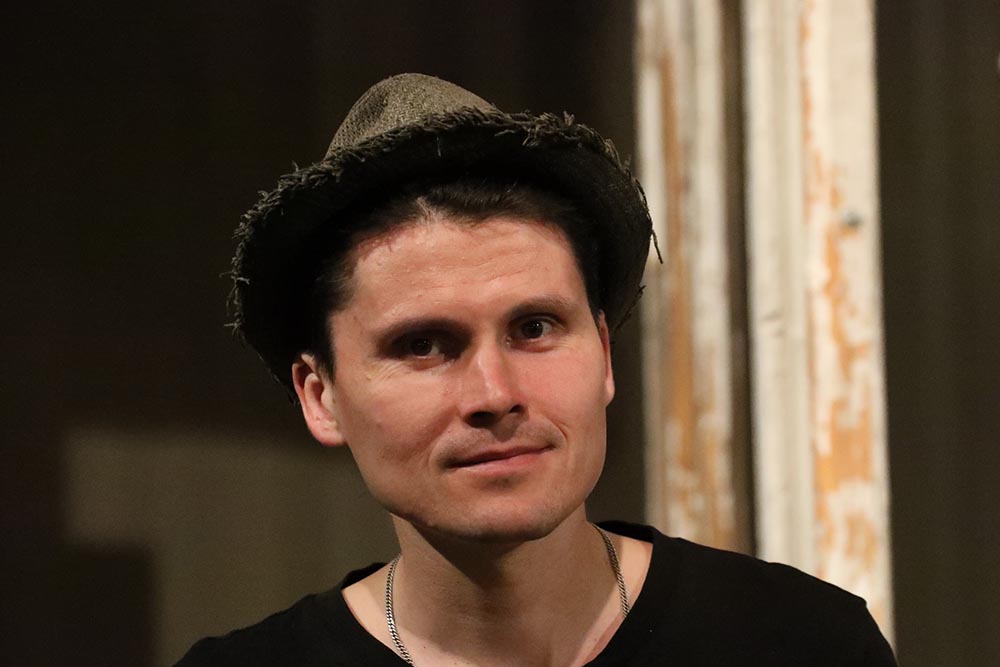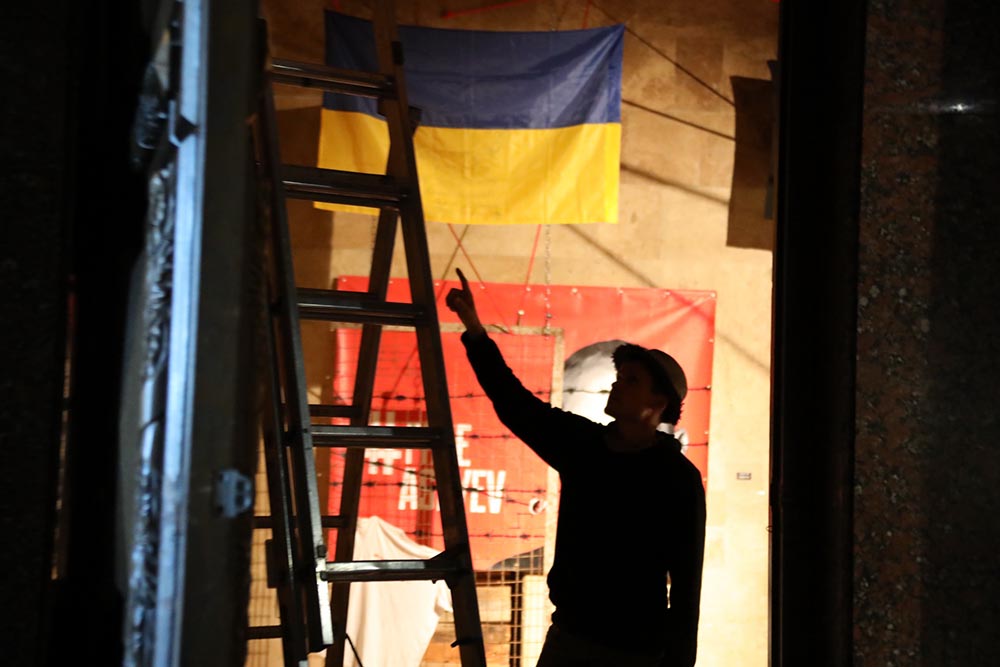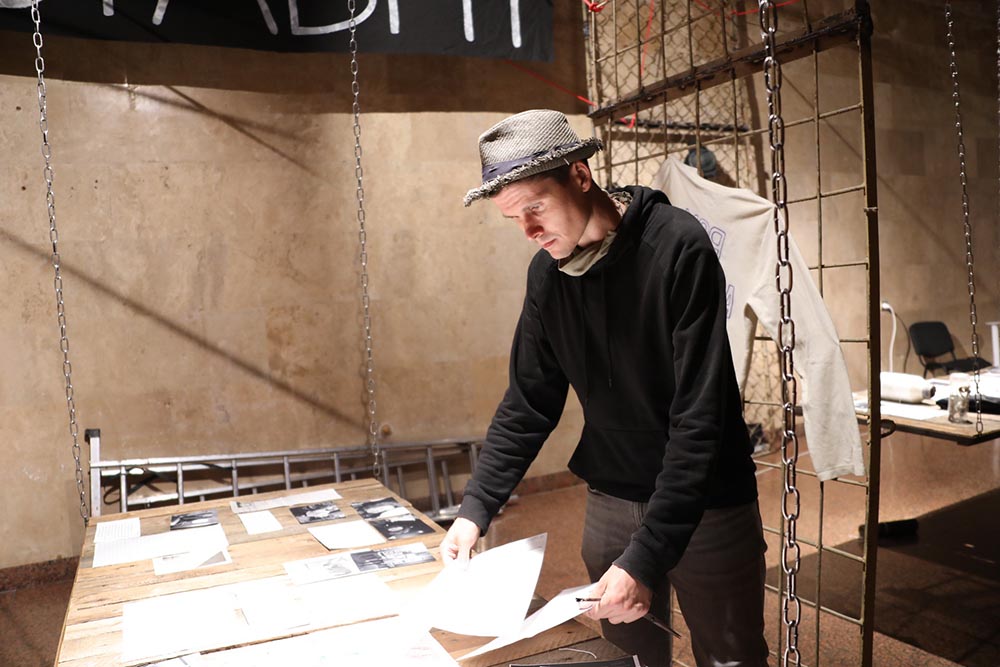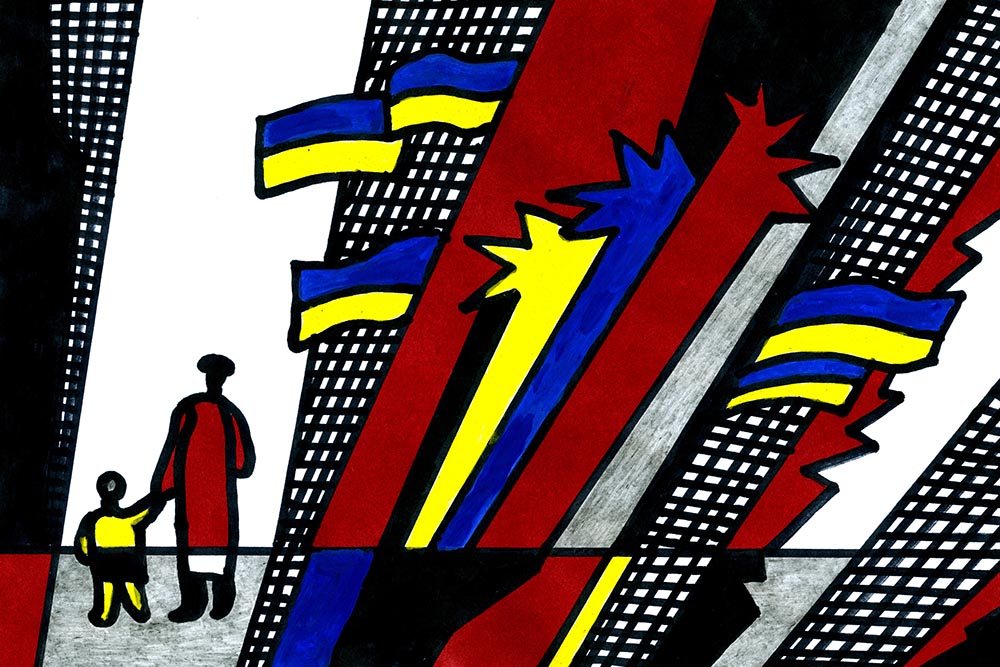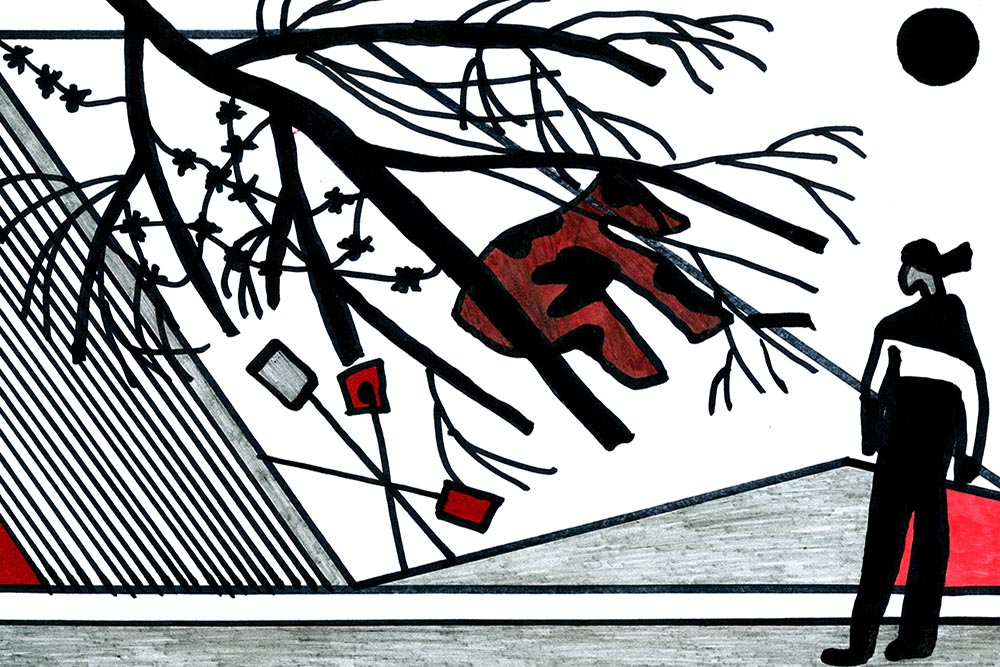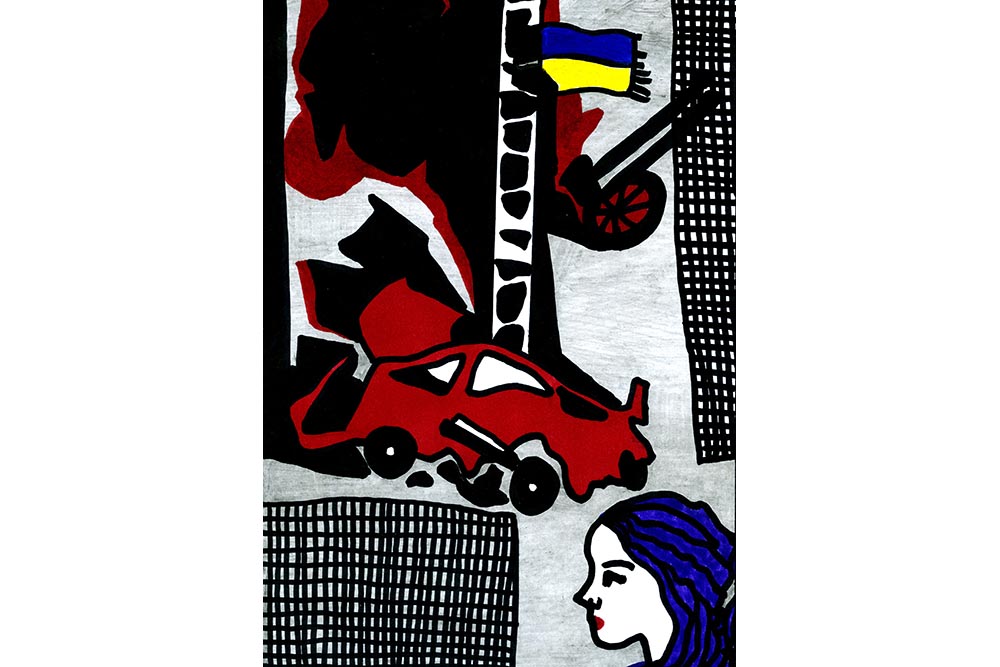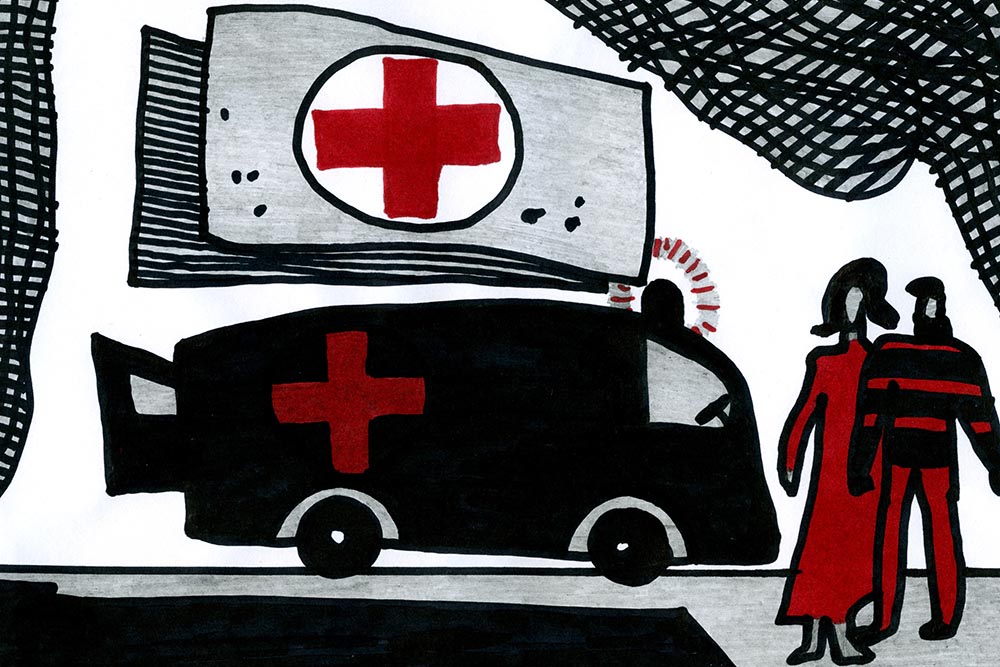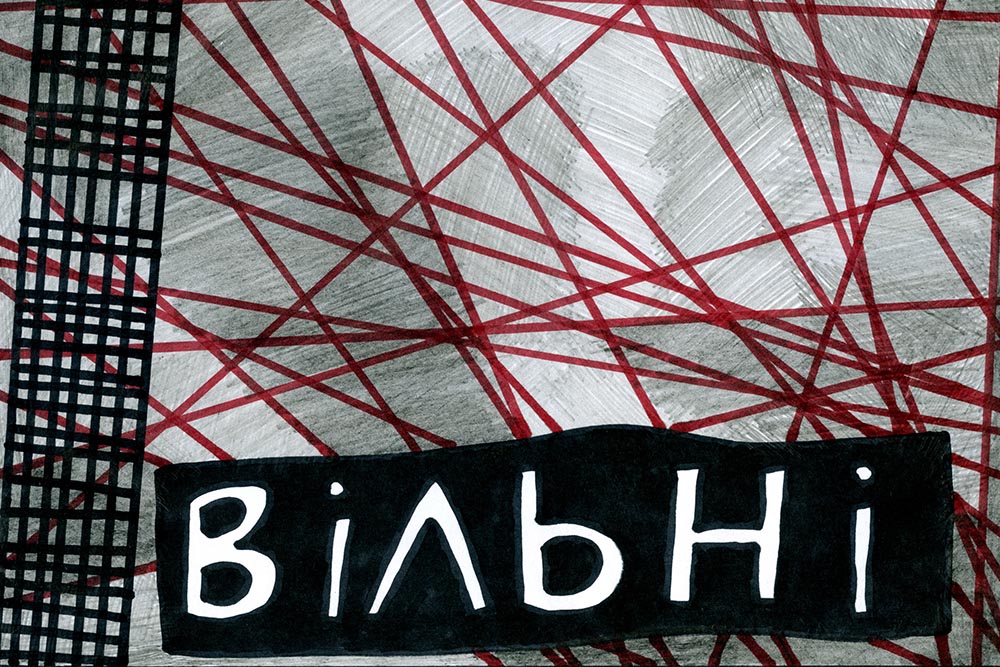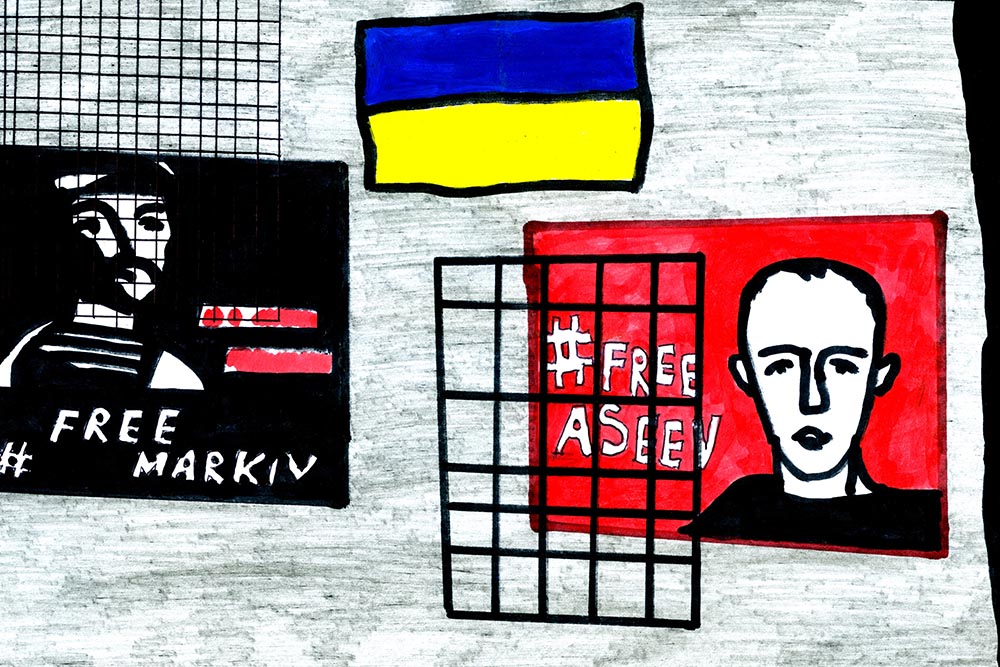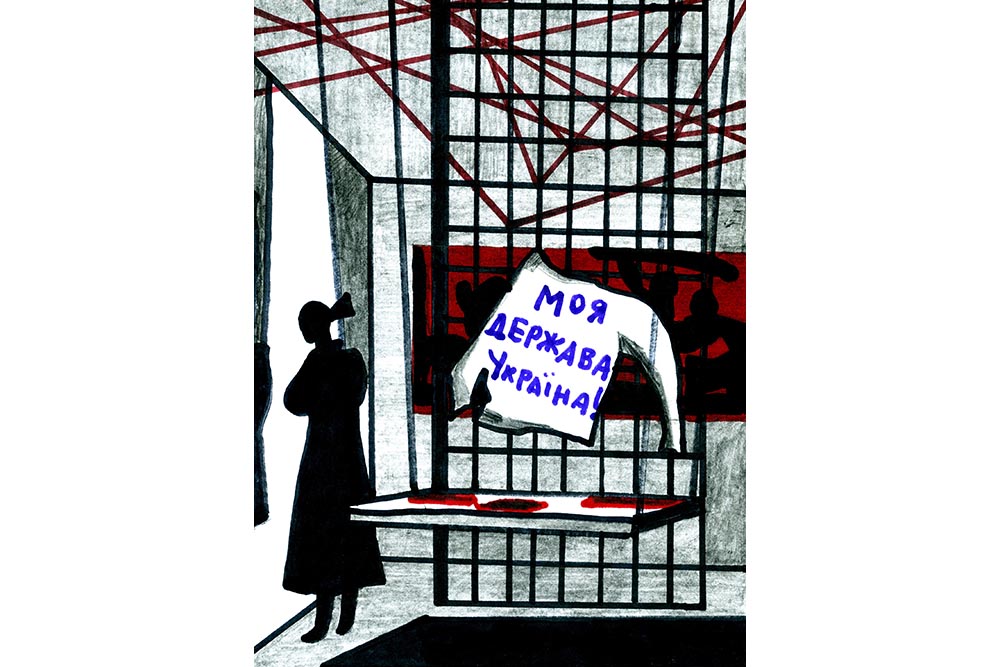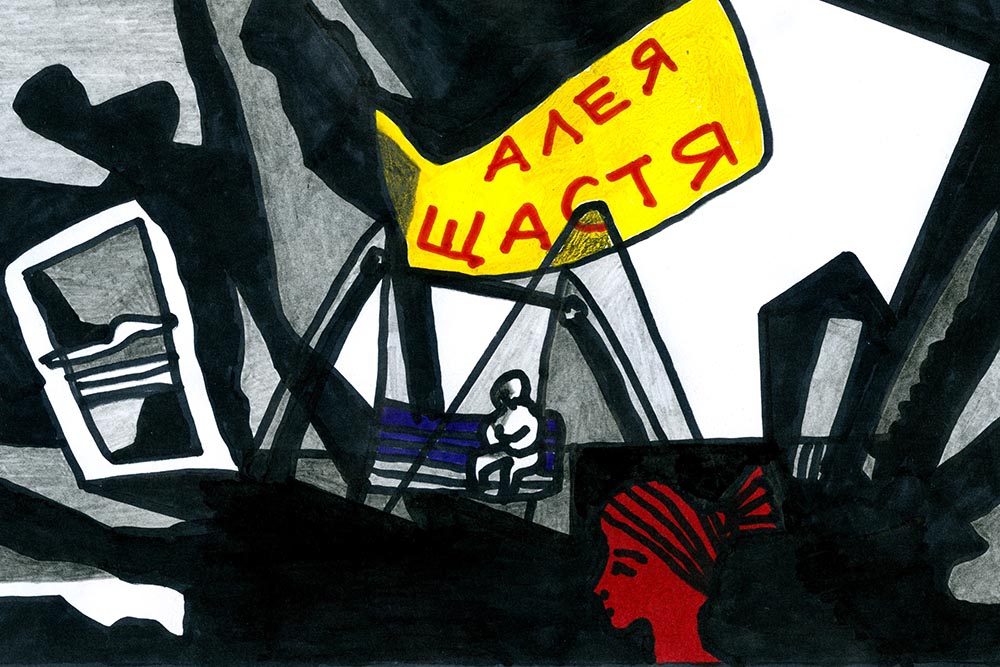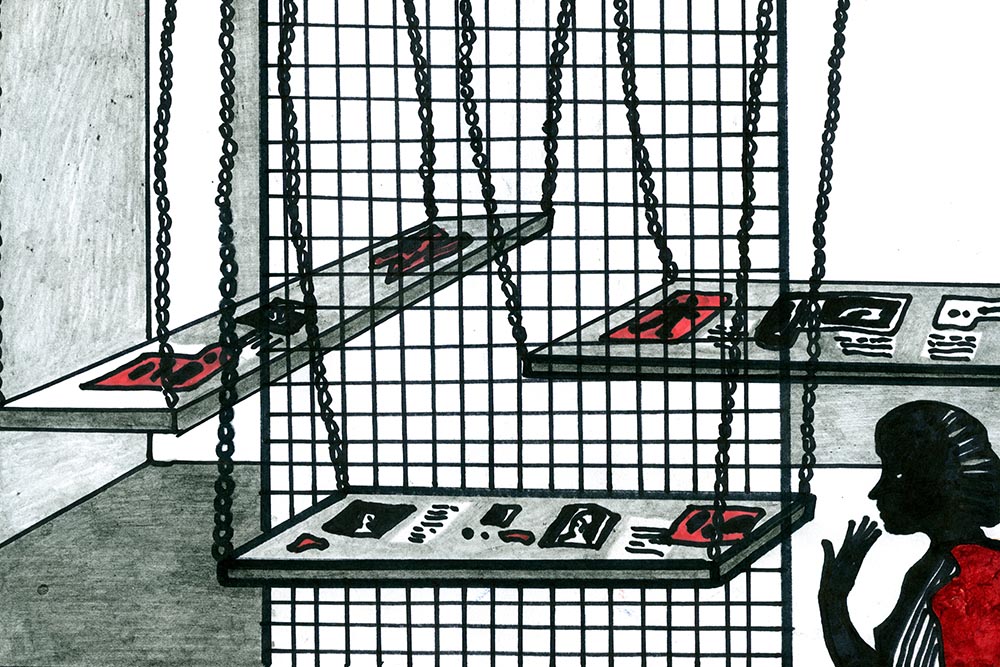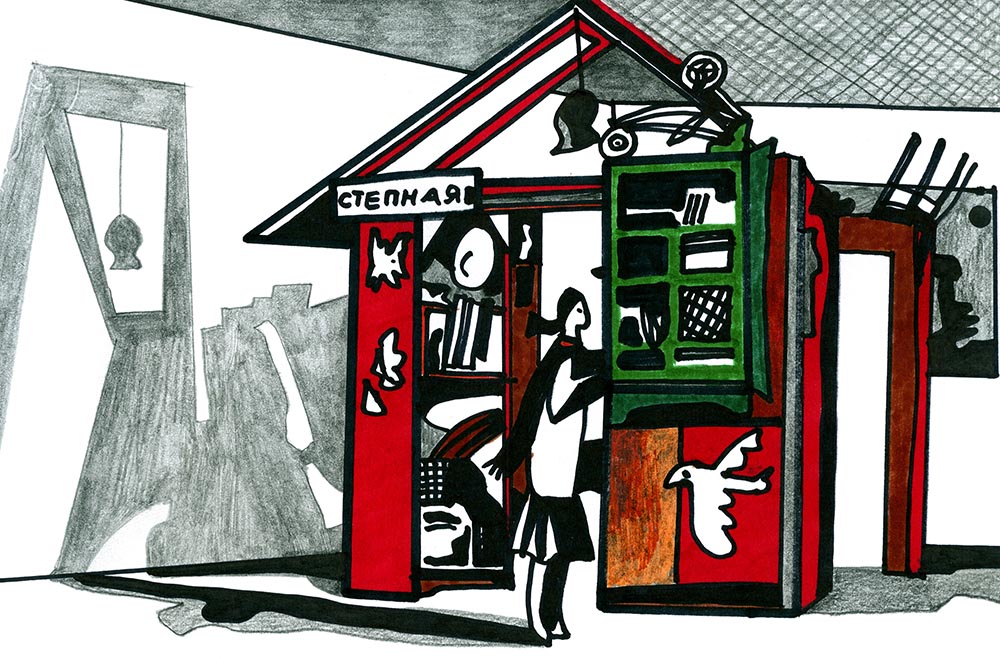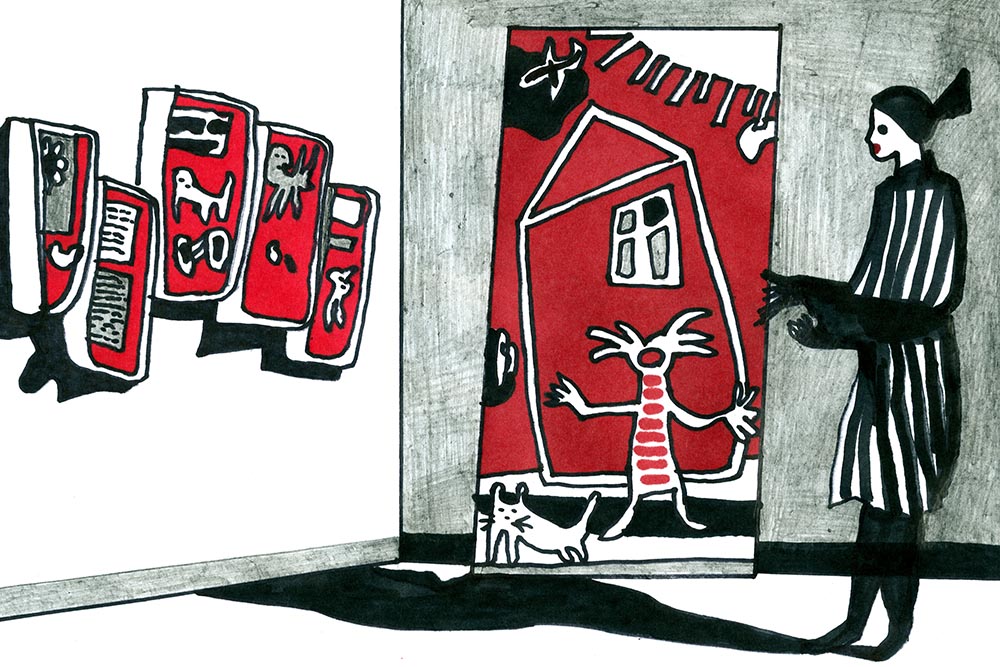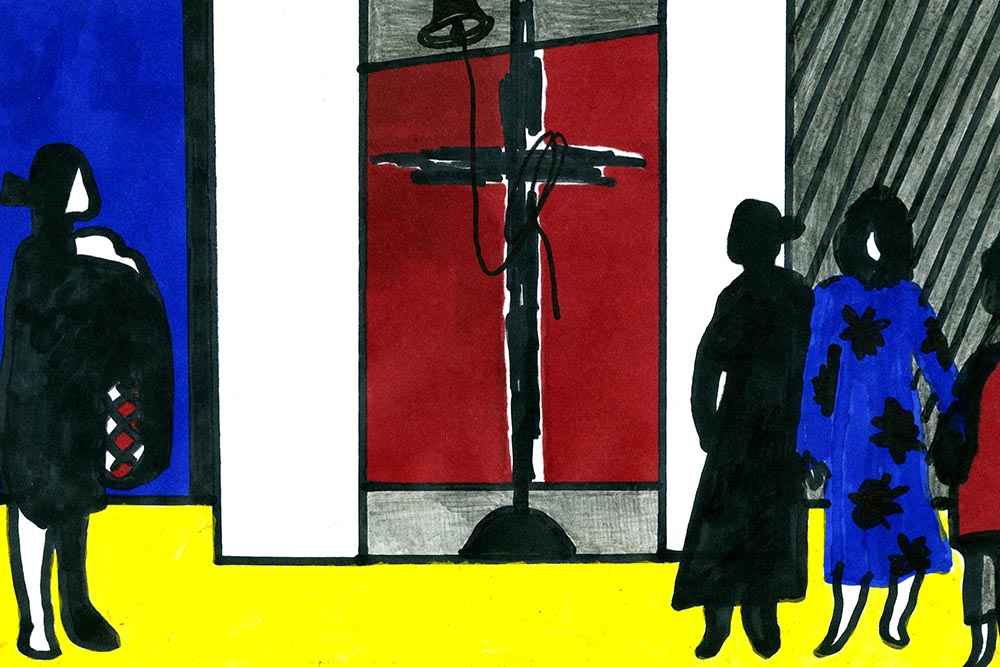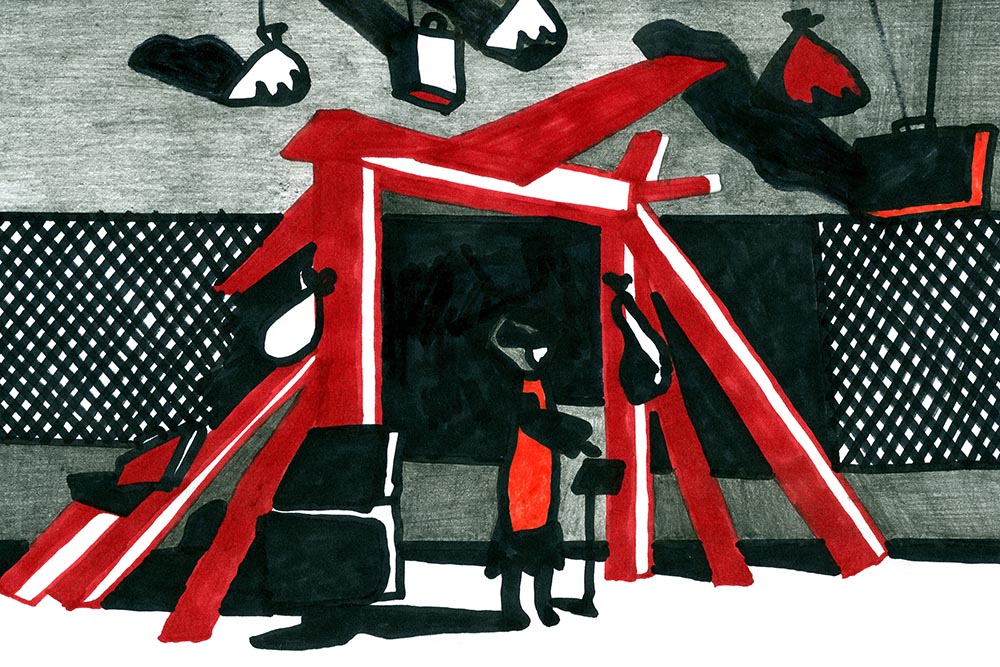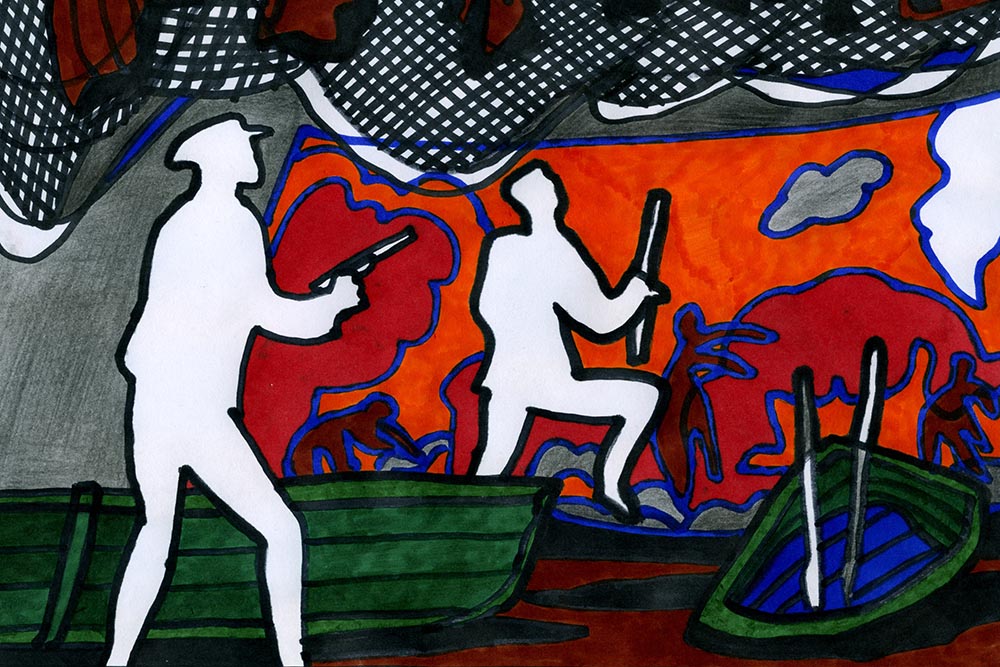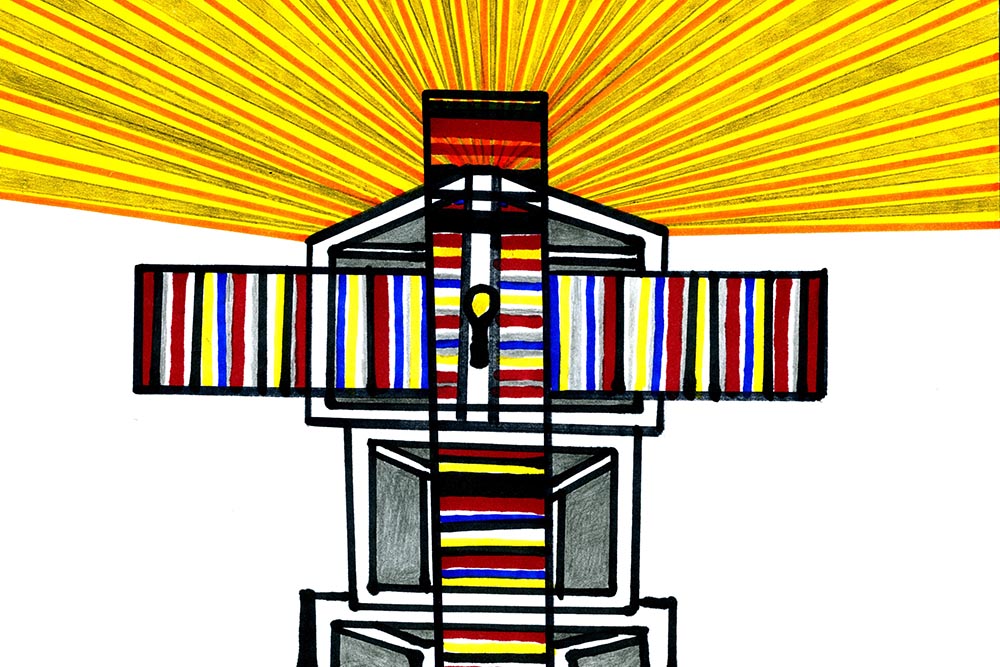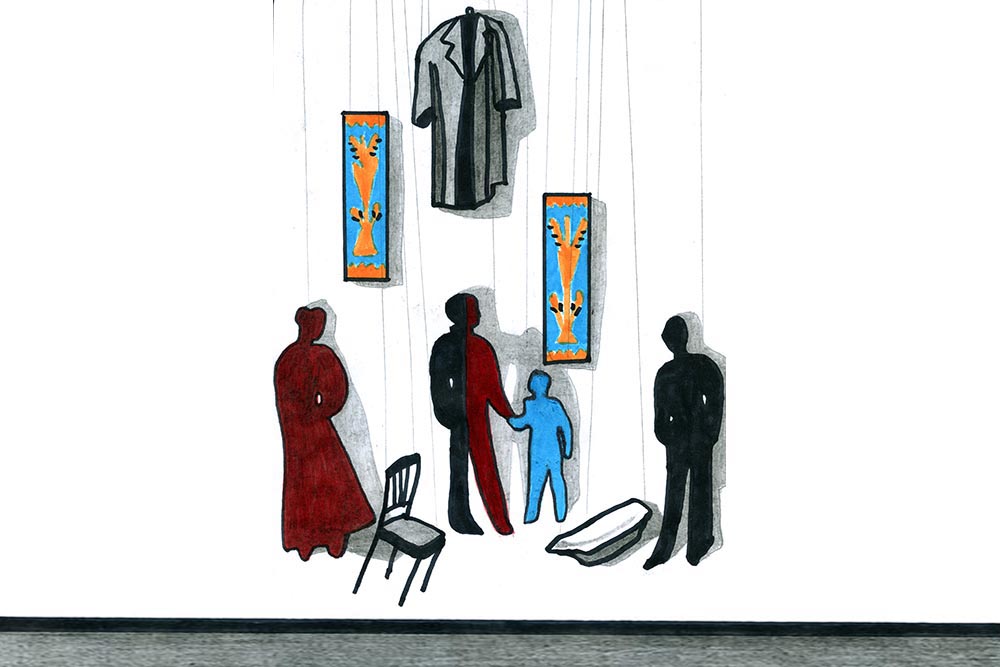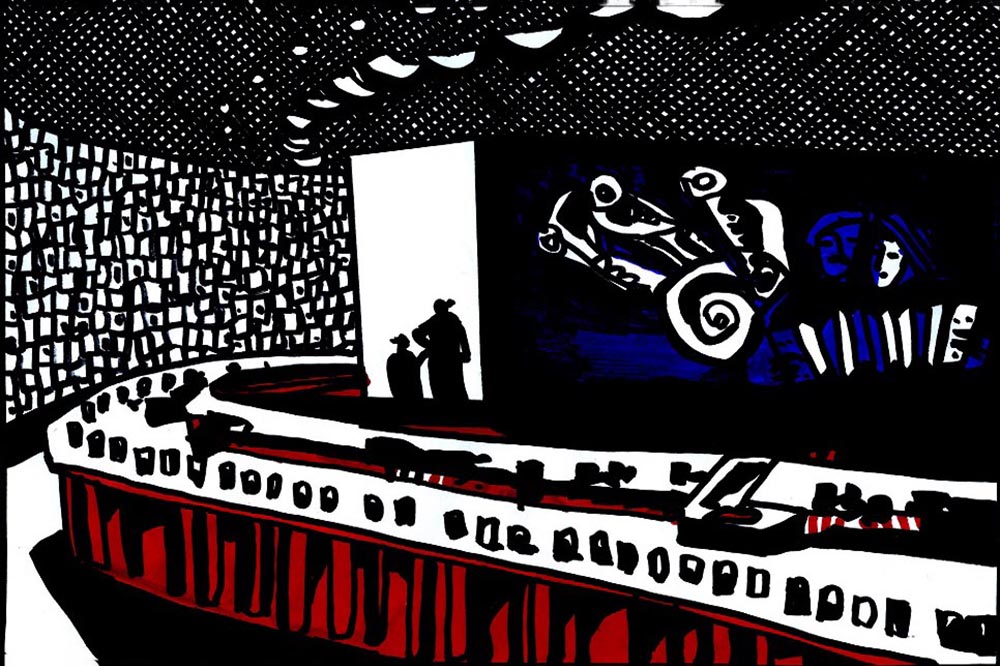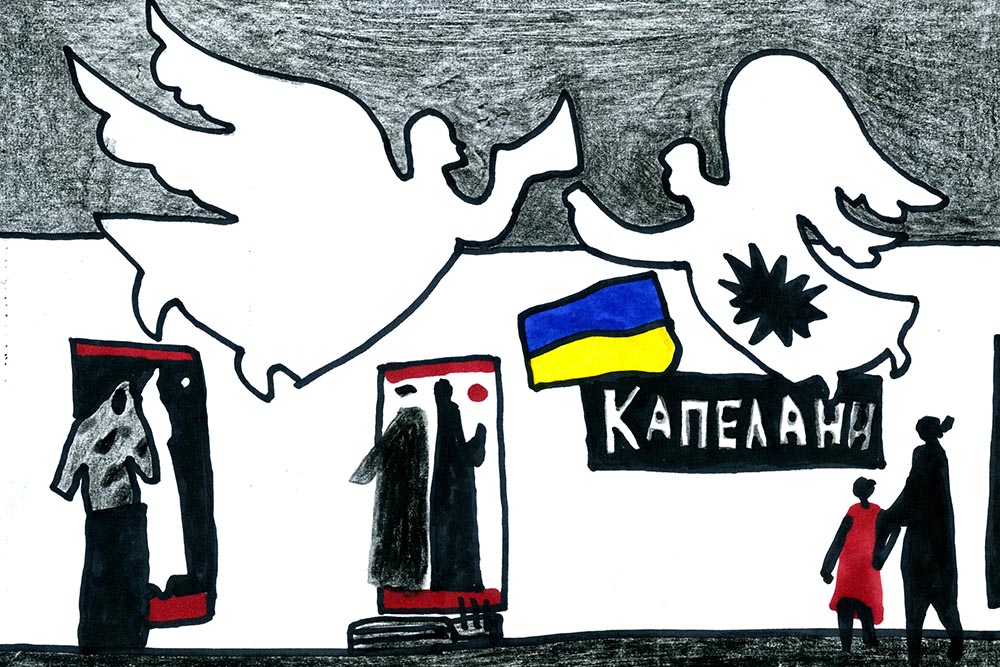PICTURES
ABOUT THE MUSEUM
The artist's work in the museum of traumatic history is not only immersion into the curatorial concept of the exhibition, the search for a general context, an acceptable form, but also a constant personal painful reflection on the tragic events that wars bring to our land. These emotions are the basis for the emergence of artistic images, design discoveries that can make acquaintance with the museum an important event in life, fill visitors with new emotions, motivate to action. The path from idea to realization is a great collective work in which everyone has a role to play. But there is a special magic how drawings on paper acquire their objective embodiment, form a museum space and begin their own dialogue with the visitor.
With "Pictures about the Museum" I invite you to an art-museum trip around an exposition, during which I will tell you about the meanings embedded in the artistic images of the projects "Ukraine. Unfinished War…”, “Hide-and-Seek”, “Free”: I worked on them. I will share my own perception and reading of the art and relic complexes created by the museum team earlier. You will have the opportunity to assess not only the quality of practical implementation of artistic ideas, but also the extent of their response in your heart. I invite you to the museum!
— Your Anton Logov
"A museum is a special reality, a living organism that you feel when you are alone with it. It strives for dialogue and is always waiting for audience. And at the same time it develops together with the visitor, encourages joint reflections, to search for answers to topical questions. When the War Museum opened its doors, it seemed to be a museum of the last armed confrontation on our land, but in 2014 everything changed… So more and more visitors in camouflage appeared, looking into the eyes of their grandfathers with a personal sore. Questions about events on the modern front were heard more often, and young guests addressed the messages to the soldiers of the Second World War asking to return and defend the country. That is why the museum exhibition project "Ukrainian East" was launched. It tells about modern heroes, patriotism, faith and the struggle for our country. "
"Wounded Earth" - the sections with this or the similar names exist in many museum exhibitions around the world. There is one in the museum story about the Second World War "Ukraine. Unfinished War… ». It also appeared in the exhibition "Ukrainian East". Years and decades pass, but the topic always remains relevant, because it is the pain of the earth from the madness and cruelty of the people. These are wounds that do not heal for years and hide death. Today Donbas is one of the most mined areas in the world. In the risk zone, which is more than 700,000 hectares of Ukrainian land - several million Ukrainians live... Every month about 40 people are blown up by mines and other explosives. Because of this, since the outbreak of the war, 234 servicemen have been killed (more than 1,000 have been wounded) as well as about 1,000 civilians (more than 1,500 wounded), almost 130 children have been injured, and at least 38 have been killed. According to UN estimates, one year of war is 10 years of demining.
Museum installation "Mined Land" is a reminder of this tragedy…
"Ascent" is a figurative connection between heaven and earth. Imaginary bridge to eternity. The path to dreams, freedom, hopes and a better future for Ukraine. A high price was paid for each step…
The core of the installation is the burned car of the Hero of Ukraine Andriy Kyzylo, Deputy Battalion Commander, who died in January 2017. Above the car there is the State Flag of Ukraine, set by Serhiy Fedorovych in the village of Verkhnya Pokrovka, Starobilsk district, Luhansk region, in protest against the pseudo-referendum of pro-Russian forces on the status of the so-called “Luhansk People's Republic”. After Serhiy's death, his wife replaced the torn flag with a new one, expressing her patriotic position.
"We will give our souls and bodies for our freedom…". The words from the anthem became a harsh reality in the Russian-Ukrainian war. International conventions, humanitarian law, written and unwritten rules have been violated. The medics have been attacked…
The ambulance with symbolic wings is a powerful museum image. It is a guardian angel, a house on wheels and a brave warrior in armor. The installation is based on the repeatedly "wounded" car UAZ-3962 ("Tablet"), which was used to help soldiers of the 57th Separate Motorized Infantry Brigade of Ukraine’s Armed Forces. Its “wings” are part of the medical module of the HMWWV M1152 vehicle (Humvee, USA) of the 79th Separate Airborne Assault Brigade of Ukraine’s Armed Forces. Holes in both vehicles are the traces of wounds of the bodies and souls of modern Ukrainians, as well as material evidence of the cruelty and insidiousness of this war.
"Arteries of Life" - red ropes that connect the elements of the installation of the exhibition "FREE". They symbolize the vessels of the "circulatory system" of former prisoners of the Russian-Ukrainian war. "Arteries of Life" combine letters with words of support from caring Ukrainians, notes, drawings, books of the prisoners. In captivity, the one cannot choose where to live, with whom to communicate, but can think, save own inner world, which will give strength for further struggle. And then the "arteries of life" will turn into "arteries of freedom" that burst out.
"Breaking the Darkness of Captivity". The exhibition area of "FREE" became a conventional metal fence – rusty, crooked, deformed, like the judicial system of a totalitarian state, where political prisoners are considered an effective element of a hybrid war. This fence is torn by banners from Kyiv buildings "#freeMarkiv" and "#freeAseyev". Until recently, they were one of the means of struggle for the freedom of prisoners. They were removed by liberated Stanislav Aseyev and Vitaliy Markiv, because the free Ukrainian spirit cannot be suppressed.
"My state is Ukraine", Olena Sorokina wrote this on her sweatshirt while being imprisoned. She was sentenced in Luhansk People's Republic to 13 years in prison for distributing pro-Ukrainian leaflets.
This artifact, located in the center of the exhibition "FREE", figuratively captures and expresses the spirit of freedom, steadfastness and life-giving power of Ukrainians for freedom. Like the entire museum, it calls the Ukrainians to unite for the struggle for freedom and a bright future for their country.
The installation "Gray Zone", as well as the whole exposition "Ukrainian East", is about the war that is still going on. But the museum objects of which this installation is made of are absolutely peaceful things. Often they are even from the world of childhood. Swing, toys, signs with inscriptions, which should express comfort and well-being… The components of this installation were not weapons, but they were destined to become targets. "Gray Zone" is a story about people who live "out of time" near the front lines – about those who grow up with children who have never seen anything in life but war. Behind these mutilated things, the sorrowful wreckage of a peaceful life, are crippled destinies, broken families, traumatized souls who are still wounded by war.
"Swings of Time" – conditional prison sleeping platforms at the exhibition "FREE", hung on chains. They symbolize the swings of Time, which throw a person from light to dark, forcing to adapt to the environment of captivity, obeying the rules and regulations of prison, and at the same time – return personality, which, despite all restrictions, remains free, to freedom. The algorithm of this freedom is derived from one's own worldview: in captivity person cannot choose where to live, with whom to communicate, but can think, saving the inner world, observe one’s self and others, help them, choose one’s own position on the outside world. One can even declare a "protest hunger strike"! Or, in order not to lose self-control and organize thoughts, prisoner can look for any ways to abstract from the situation: correspondence, reading, drawing with unusual means, writing poems, memoirs, notes to future books or scripts, and so on. This frees up the time when one can think about freedom, family, the future of the motherland. In the artist's imagination, prison beds are transformed into a museum platform, on which documents and artifacts are exhibited.
The installation was inspired by the memories of Roman Sushchenko, a project consultant.
The exhibition "Hide and Seek" echoes the mood with the installation "Gray Zone", because it is about the same line of territory, the inhabitants of which risk their lives every day. However, in the exhibits, which recently were commonplace, a special tragedy is learned.
This symbolic house is an allusion to the well-known expression "I'm on base!", which means that the little player is out of reach, that he is protected from any threats. But, unfortunately, war is not fun at all, and it unfolds according to other, cruel, rules. Children are the weakest and most vulnerable people. To hide from the deadly metal is the most difficult for them.
This installation is an artistic reminder of the more than 20,000 underage Ukrainians who remain in Donbas under enemy fire to this day. Above the angel depicted like children's drawings and on top of the wounded piano "Ukraine" you can see shell casings…
Exciting children's game "Hide and Seek" acquires a completely different meaning when the war comes to the house with great trouble. This is the subject of the Sunny Day art object. Symbolic doors that can become a portal to comfort and protect from danger. Because peace is where a bright house on a bright street, where a child and a white cat walk without fear. But this figure of an airplane and a dark cloud are frightening. The plane is hostile. However, the threat will definitely be overcome. It will definitely disappear, and the sun's rays will envelop the entire threatening space.
Meanwhile, the children continue the "game". They have always been interested in hiding themselves or hiding something very dear to their heart from someone. The ideal place for storage is a drawer. At the exhibition "Drawers" - a cache of children's toys and drawings with words of support for Ukrainian soldiers. Their authors are girls and boys from peaceful territories. The theme of creativity for young artists was reflections on modern war and peace. They also see their personal defenders in the military, feeling that at some point they may also become hostages of adult games. All children, without exception, need family warmth and comfort in a peaceful home.
The wars and armed conflicts of the 20th century took lives of millions of people. Unfortunately, this bloody chain is not broken in the 21st century.
“Warning” is the final installation of the museum’s exposition. The symbolic cross is made of remains of the Soviet and German weapon. It is the warning for humanity of fueling any wars. The Bell of Memory reminds of peace as the costless treasure of all the states and nations.
This cross could become the symbol of faith in the victory over the war as well as any possibility of it in future. The special final point of the exposition could be the starting point of the new history of mankind – the great history of farewell to arms, the mutual forgiveness and peace. However, there was no farewell to arms. The war is in Ukraine again.
Installation "The Gates of War" attracting attention because of its originality is the start of the visitor's tour at the exhibition "Ukraine. Unfinished war…".
As well as the history itself, this figure could be interpreted in different ways. People familiar with the Japanese religion of Shinto can recognize thorium - the ritual gate separating the world of alive people from the dead ancestors' world. However, the museum is also the kind of portal between the presence and the past - the place to face the previous generations - in particular those who passed away.
For the current young generations "The Gates of War" is a thin border separating the peaceful past and the modernity affected by the new war. For the participants and witnesses of the World War Two it is a border between their prewar reality, definitely not the ideal one, and the future which scared by its uncertainty even in that dramatic background. What expected people after the outbreak of the war? Mobilization to the front? Evacuation? Deportation? Destruction of the home? This feeling of danger to the usual way of life is reflected through the symbolic sacks and bags - the everyday attributes of people losing their homes.
The hidden element of the art installation is the plane. For many people experiencing the war the sound of the aviation engines meant danger. If you hear it - be aware of bombardment. It was the first sound of the war carved in the memories of the Kyiv residents on June 22, 1941. The engine of war splitted the life into "before" and "after", turned it upside down, tearing the millions of people off their homes.
The Memory Reflection installation is an invitation to travel through time and space. Autumn 1943. The bank of the Dnipro river. In the midst of forcing a water barrier…
Those events are about a cruel and large-scale "Battle for Ukraine". Images of the participants of this bloody epic appear between the boats, which are ready to embark on a dangerous journey with the Dnipro waves full of bullets and shells. Some of them were lucky to reach the right bank, some found eternal rest in the cold waters. In each of them – our reflection. We are reflected in them as they are reflected in our Memory.
And above all, among the waves of Dnipro, as a requiem for unjustified losses – sweatshirts of “black jackets”, forced by "field military enlistment offices" and thrown into the infernal "meat grinder" of war. Traces of these unfortunates, entangled in the web of war, are lost in the river mud and on the banks. Even now, fishermen sometimes extract soldier's bones from the dark waters of the Dnipro river, a terrible harvest of war.
And "I would like just to die my death so that my bones do not fall on the ground…" – words of one of the exhibition’s heroes.
Installation “Between Heaven and Earth”. According to the folk cosmology, its space is divided into three symbolic levels: human world, heaven world and hell. The core of composition consists of the woven carpets made by the forcibly relocated family and the window frames of the abandoned house.
Above there is the huge cross carried by those who lived “there” and “here” – on the inner side of the front – in the wartime. The image of the window symbolizes the portal between the comfort zone and the outer world. “A man’s home in his castle” – when we are on the inner side of the window, we are safe. However, in the era of relocation and deportation the understanding of home as the “man’s castle” disappeared: at any moment the one’s microcosm could be destroyed after some bureaucrat’s signature. Below, between heaven and earth, there is reflected look into abyss of space and time, the thin border separating human world from hell. Then the whole family left home for a long uncharted road...
In 1952 the residents of Sobiatyn village in Volhynia, North-West Ukraine, were deported to the Dnipropetrovsk region for supporting the insurgents and resistance to collectivization. On the new place were total poverty and misery. Making and selling carpets was the only way to earn some small money.
Installation "Silhouettes of War" is the artistic reflection on the cost of the bloody conflict between states for the ordinary family.
Nameless, faceless… Warrior who did not survive or came back wounded, mother in sorrow, young widow, orphaned children. The child is the only pure-blue silhouette, free of hate, fear, pain. Unfortunately, the war changes all this.
This image of the family tragedy is eternal. Someone can recognize it as the echo of one's own family memory of war. Which one? That unfinished war that destroyed everything over seven decades ago or the one that came to Ukraine in the XXI century? Their silhouettes are the same.
Hope for return of the Ukrainians from the (un)finished war grows as the Tree of Life on the shutters painted by the folk artist Anastasia Rak from the Poltava region, sounds as the child's laugh from the cradle of the Haidamaka family from the Chernihiv region.
The attitude to human life as the highest value determines the civilization and maturity of the nation. Therefore, the memory of the Ukrainian people about the war is the memory of every life lost or mutilated.
In the Hall of Remembrance - more than 6,000 photos. It is a collective portrait of the generation that suffered the bloodiest war in human history.
Between the photos - a symbolic funeral table. Two rivers of death certificates flow on it.
Unfortunately, the unfinished war is still gathering its bloody harvest. The crane wedge of our memory is joined with new birds every day. And only the joint efforts of the world community and each of us can stop those who, ignoring the lessons of history, started to redraw the map of Europe again. After all, remember the prophetic: "For whom the bell tolls? It tolls for thee… ».
There, in the Ukrainian East, where the war continues and blood is shed, the military chaplains, the clergymen of various religions and denominations, defend the territorial integrity and independence of our Motherland side by side with the soldiers and carry out their pastoral mission with dignity. They are the Clergymen, who also have their special mission – to save the lives and faith of the Defenders of Ukraine themselves, and ultimately, to win the War in the human heart. After all, only Love can overcome the Evil.
Іn the apocalyptic dimension of military life, the chaplains are not only Priests, but also Friends, Brothers, Counselors, Psychologists. The principle of “Be close!” is always with them.
